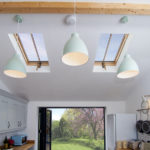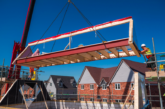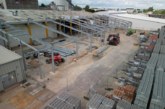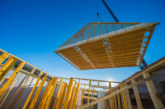Paul Trace from Stella Rooflight discusses the practicalities involved in specifying large rooflights.
As a bespoke rooflight manufacturer we often see grand plans with expansive areas of roof glazing, as architects continue to seek innovative ways in which to exploit natural daylight. As much as bespoke rooflights can certainly help bring these designs to life, there are some important factors that need to be considered when the glazing is turned from drawing to reality.
In recent years we have noticed a trend towards larger rooflights, with sizes regularly exceeding 2,500mm in width, height or both. While Stella can certainly accommodate these, one has to appreciate the practicalities of weight, transportation and cost.
It stands to reason that the larger the rooflight, the thicker the glass will need to be, therefore as rooflight sizes get bigger their weight can increase exponentially. In context, our double glazed units comprising 4mm thick glass weigh 20kg/m2 and those using 6mm are 30kg/m2. Triple glazed units are 30kg/m2 and 45kg/m2 respectively. Add the stainless steel frames and hardwood liners into the equation and you can start to see how even a modest sized rooflight can weigh something akin to a small elephant! Indeed it’s not uncommon for us to produce rooflights weighing in excess of 200kg.
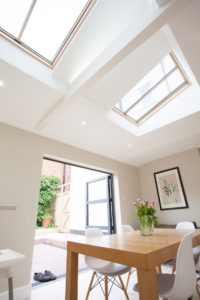 The reality is that when you scale things up even the simplest plans can start to become complex – a truth that should be all too familiar to developers. But before drawing that large rectangle on a roof plan, it is important to consider how the rooflight is going to be lifted from the ground to roof level and what the weight implications might be for the structure. Stella can weld stainless eyelets to the rooflight frame to aid the lifting process and we would suggest doing this on frames which weigh in excess of 100kg, which is the point where we expect a crane might be required. However, does the site have suitable access for any specialist lifting equipment, and has this additional cost been budgeted for?
The reality is that when you scale things up even the simplest plans can start to become complex – a truth that should be all too familiar to developers. But before drawing that large rectangle on a roof plan, it is important to consider how the rooflight is going to be lifted from the ground to roof level and what the weight implications might be for the structure. Stella can weld stainless eyelets to the rooflight frame to aid the lifting process and we would suggest doing this on frames which weigh in excess of 100kg, which is the point where we expect a crane might be required. However, does the site have suitable access for any specialist lifting equipment, and has this additional cost been budgeted for?
The weight of an opening rooflight will also determine whether it is manually operated or requires electric actuation. We would suggest that our largest manually operated rooflight be around 1,000mm wide or 1,400mm high. Anything over this size will generally require electric actuation to lift the weight and in the case of wider casements, to provide a tight seal. Manual operating casements are less expensive than electric so there is a cost element that also needs to be considered when specifying larger opening rooflights. There is no maximum size in terms of what is possible to manufacture, although it is worth keeping in mind that a single piece of glass with an area over 5m2 becomes significantly more expensive.
Fortunately there are alternatives to using large expensive single panes of glazing, such as introducing glazing bars to reduce the unit sizes, linking frames, and having more than one casement. This not only makes the rooflights easier to transport, lift and install, but can also reduce the price.

